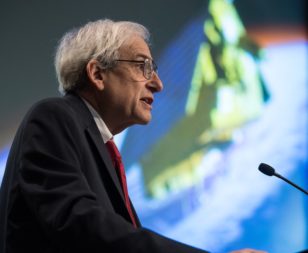WASHINGTON — NASA and its domestic and European partners have renamed an upcoming Earth science satellite after the agency’s former Earth science director.
At a Jan. 28 ceremony at NASA Headquarters, officials from NASA, the National Oceanic and Atmospheric Administration, European Space Agency, Eumetsat and European Commission announced the latest in a series of spacecraft to measure sea level height will be named after Michael Freilich, who retired last year from NASA after more than a decade as the director of the agency’s Earth science mission.
The spacecraft, which has previously been known as both Sentinel-6A and Jason-CS, will now be called Sentinel-6 Michael Freilich. It will launch in November on a SpaceX Falcon 9 from Vandenberg Air Force Base in California.
“This is really coming from all of our hearts. It is to you, Mike, for what you have done in order to make Sentinel-6 happen,” said Josef Aschbacher, director of ESA’s Earth observation programs, who announced the name change. “Sentinel-6 would not exist without Mike Freilich’s contribution.”
Sentinel-6 will continue space-based measurements of changes in sea-level height that date back to Topex-Poseidon, a joint mission between NASA and the French space agency CNES launched in 1992. It was followed by Jason-1 in 2001, Jason-2 in 2008 and Jason-3 in 2016. The last two missions included NOAA and Eumetsat as partners.
With the upcoming mission, ESA and the European Commission became involved through their joint Copernicus program for Earth observation. ESA is responsible for the satellite, being built by Airbus Defence and Space. Both ESA and NASA are providing instruments, with NASA responsible for launch services. Eumetsat and NOAA will support ground stations, operations and data dissemination. The partnership includes a second spacecraft, Sentinel-6B, scheduled for launch in 2025.

NASA used the event to emphasize its continued commitment to Earth science. “We know the Earth is changing constantly,” NASA Administrator Jim Bridenstine said, with human activities responsible “at least in part” for those changes. “We know there is a whole lot more to learn about each of the systems that comprise the entirety of the Earth.”
The ceremony was also an opportunity to honor Freilich, who retired from NASA nearly a year ago after serving as director of NASA’s Earth science division since 2006. Officials from both the United States and Europe praised Freilich’s career in the Earth sciences and his leadership while running NASA’s Earth science programs.
Stephen Volz, assistant administrator for NOAA’s satellite and information service, said that the offer by European partners to name the spacecraft after Freilich “is a suitable recognition of Dr. Freilich’s career and lifetime of contributions, not just to altimetry but to Earth science in general.”
“I’m more than humbled by this great honor,” Freilich said at the ceremony. Measurements of sea-level heights, he said are among the “most robust” measurements of climate change, and why it was important to continue such measurements with international collaboration.
“Our ability to do precision altimetry over the decades, and to implement Sentinel-6 now, is possible only because of the vision and the contributions of thousands of scientists, engineers, managers, and diplomats from both sides of the Atlantic,” he said.
In an interview after the event, Freilich said he heard about the offer by ESA to name the satellite after him a couple months earlier, shortly after ESA contacted NASA. “It’s pretty overwhelming,” he said.
The spacecraft is only the second time that a mission involving NASA has been named after a living person. In 2017, NASA renamed the Solar Probe Plus spacecraft the Parker Solar Probe after Eugene Parker, a professor emeritus at the University of Chicago who correctly predicted the existence of the solar wind. The spacecraft successfully launched in August 2018, with Parker among those in attendance.
#Space | https://sciencespies.com/space/earth-science-mission-named-after-former-nasa-official/
No comments:
Post a Comment